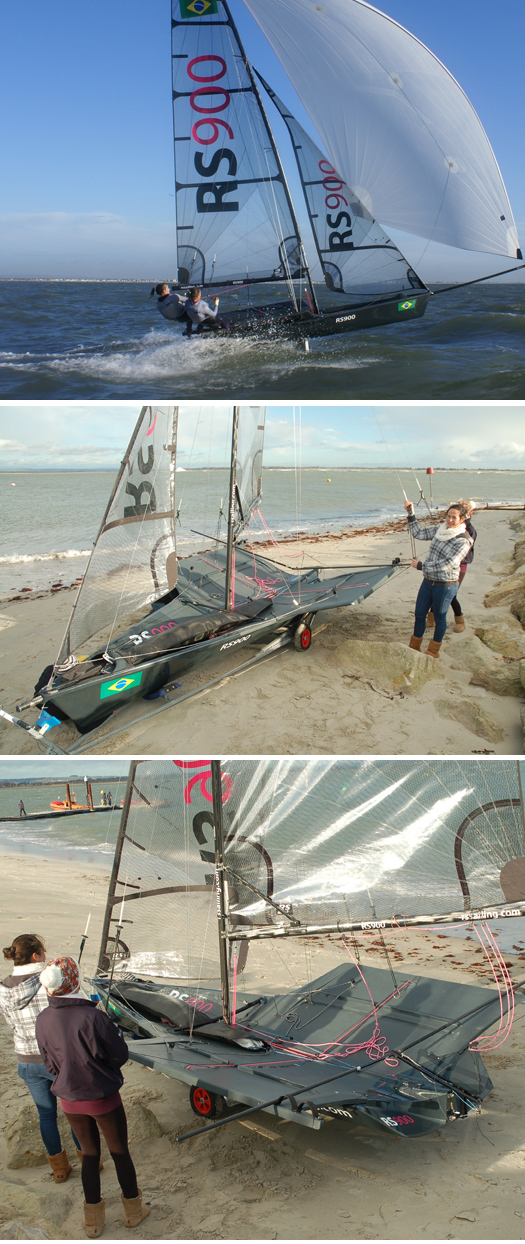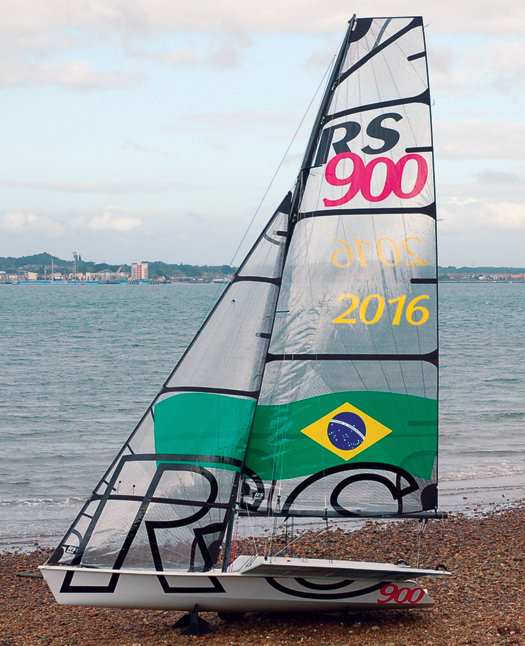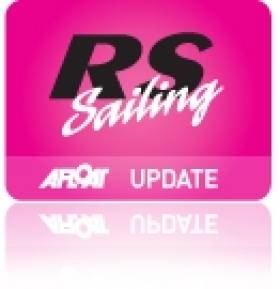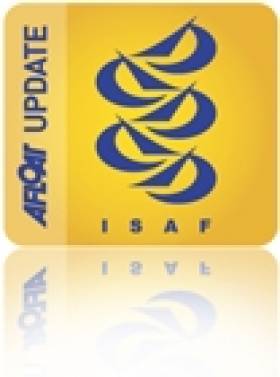Displaying items by tag: Skiff
RS Boat Builder Reveals New Women's Skiff
#SKIFF – Testing of the production specification RS900, RS Sailing's contender for selection as the new women's Olympic skiff, is underway. It's a sleek looking affair as you might expect that will take women's sailing into a whole new area because it has been designed especially for lighter crew weights.
"We believe that a new generation of elite skiff sailors deserve a purpose designed boat that will excel in the role and stand the test of time" says RS managing director, Martin Wadhams. "After several changes to the women's classes over recent Olympic cycles, the last thing anyone wants is another short term measure. We began the process several years ago believing that the RS800 could be modified to become the women's skiff, but quickly realised that although it was arguably the most suited of the then current bunch, it would never be perfect for Olympic women. So our own RS team of Alex Southon and Nick Peters has worked with Phil Morrison to start from scratch and design the RS900 without compromise."

The RS900 hull is shorter, narrower and has lower freeboard – smaller all round to suit light female teams. The reduced surface area allows a corresponding weight reduction whilst using a similar long lasting, epoxy foam sandwich construction system to the 800.
Fully integrated wide, solid wings and a smooth run-through deck on the RS900 facilitate athletic sailing. RS900 sailors will use techniques matched to those of the 49er men, allowing shared training in many regions, especially helpful for smaller sailing nations. As you can see from the photos, the wings fit smoothly into the hull providing arguably the most flowing platform of any skiff, plus structural integrity and seriously good looks.
Structural engineering has played a major part in the design development of the RS900. RS technical director Alex Southon has significant, hard-won, volume production experience and he has enlisted input from world class composite engineering experts in the USA on this project to help him create a boat that is not only strong and long lasting, but also efficient to build. This will keep costs low for a skiff of this type and the RS900's price will in line with a competitive 470 rather than the similarly high performance 49er!
The rig is matched to wide leverage to produce spectacular performance whilst suiting the110 -130kg crew weight range specified by ISAF. The jib is tacked onto the bow, with the forestay attachment point pushed as far forward of the forefoot as possible to give maximum low-down jib area, without excessive hull length and correspondingly reduced responsiveness. The relatively straight mast and square head mainsail follow the latest skiff design trends and, of course, a masthead spinnaker maximises downwind performance.
RS Sailing has the proven ability to produce a large number of epoxy racing dinghies quickly - last year around two hundred RS100s were built and delivered to destinations across the globe within 12 months of launch. Their international dealer network provides back-up support with parts and sails.
Final testing of RS900 will continue over the coming months in the run up to ISAF's evaluation trials which are expected to be held in March 2012, although as Alex Southon says "We're talking about details now from a development perspective. The 900 works and all the sailors who've been in it so far are really excited – so we'll just keep tweaking the rig and getting miles under the hull until we have to stop!"
RS900 Put Forward as Women's Olympic Skiff Contender
Following ISAF's final choice of sailing events for the 2016 Olympics, including a women's skiff, RS Sailing has announced it plans to develop the RS900 to compete for this role.
While that selection decision is yet to be made by an evaluation team across a range of designs a more immediate issue for Ireland is trying to find an Irish women's crew to campaign such a boat for Brazil.
There is huge interest in the new skiff style sailing internationally but Ireland have not had a double handed women's dinghy crew since Atlanta 1996 so gauging interest here in the new class might be difficult.
The RS900 will be an all-new boat incorporating developments from the highly respected RS800 hull, a new deck, new wings and a new rig. The RS900 will only go into full production if it is selected for the Olympics.
Early testing of a prototype RS900 has shown the performance can be close to a 49er - with optimised handling targeted to suit ISAF's specified weight range for female teams.

The new RS900 - a new Olympic class?
RS Sailing is also one of the very few companies with proven credentials for the production of one-design race boats in large volumes, plus an established global distribution network – able, therefore, to be a strong partner for ISAF in the successful introduction of a new flagship Olympic event.
"This is a serious project for us" says Martin Wadhams, managing director of RS Sailing. "It will take a great boat to do justice to the Olympic role and a new generation of female sailing athletes. It will also take a significant commitment to work with ISAF on the strategy to launch the new class quickly and effectively if it wins selection. We're up for that."
Nick Peters, head of development at RS Sailing comments "We learned at lot from the initial women's skiff trials at Hyeres four years ago. The RS800 which we took there was perhaps the closest existing class to meet the requirement range of a new Olympic boat – but we understood that the final boat we put forward would need to be more responsive, faster and more challenging to sail. Early sailing of the new RS900 leaves us in no doubt that we have a worthy skiff on our hands. We just need final confirmation of some key evaluation criteria, such as the target sailor weight range, to allow us to confirm we'll undertake the investment needed to compete and then refine the boat to the role."
A number of key features can be seen from the photos, but are liable to change. More technical details will be released as development progresses and all elements are finalised.
No Recommendation for Mens Keelboat Poses Problem for Star
There was big news yesterday from the ISAF events committee meeting in Athens. The conference blog reports A 'packed session' heard the Events Committee's recommendation on the provisional Olympic events and equipment for 2016.
The Events Committee recommends:
- Board or kite-board for men and women - equipment evaluation
- One person dinghy men - Laser Standard
- One person dinghy women - Laser Radial
- Two person dinghy (skiff) men - 49er
- Two person dinghy (skiff) women - equipment evaluation
- Second one person dinghy men - Finn
- Two person mixed multihull - equipment evaluation
- Two person mixed dinghy with spinnaker - 470
- Women's keelboat - Elliott 6m
In so doing the committee's voting recommends taking out the men's keelboat. The second one person dinghy for women was the other option not to be selected.
The Committee's recommendations are of course just that. They will go to the ISAF Council for consideration this weekend. After Council vote they are then subject to confirmation at the ISAF Mid-Year meeting in May 2011.
High Speed Thrills on Friday at Inaugural 'Liffey Skiffy'
Tomorrow join skiff sailors for some Dublin city centre sailing action as High Performance Olympic 49er Skiffs will be racing on the River Liffey between the East Link Bridge and Samuel Beckett Bridge.
Crews from Ireland and the UK including Olymians, Olympic campaigners and professional skiff sailors will be carving up some tight maneuvers in the confined walls of the River Liffey.
There'll be 4 or 5 short sharp races and all are welcome to view the spectacle from the North Wall Quay and Sir John Rogerson's Quay. Expect to get very close to the events as they unfold. There will be no lay lines... Just walls!!! Event proceeds will go to the Peter Mc Verry Trust.




























































